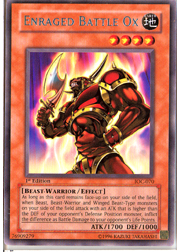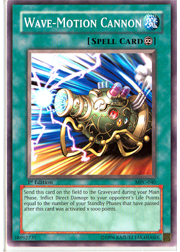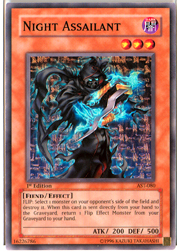There's always tech at a big event. Sometimes you need to dig for it, but those individual cards unique to the metagame are always there, somewhere, just waiting to be discovered. When they are found and identified as special little morsels of playability, they can form the environment of the following months just as frequently as they can fizzle out entirely. Great cards have fallen by the wayside in the past, but such cards are also sometimes latched onto and used by thousands of duelists at a time. With US Nationals just around the corner, we're most definitely aiming for the latter.
Here are four offbeat cards that had the biggest impact on Shonen Jump Championship New Jersey.

Enraged Battle Ox: Not just for Beast decks any more
Enraged Battle Ox was the weapon of choice for those looking to counter
Scapegoat. While
Enemy Controller saw a fair amount of play, it was definitely down in numbers compared to previous SJC events.
Windstorm of Etaqua was virtually unseen, and the reason for both of these trends was
Enraged Battle Ox. Offering a simple and easy way to smash through
Scapegoat and punish players running multiple copies of the frustrating defensive powerhouse, it slid easily into virtually any battle-oriented deck.
While the Ox is a poor monster to open with, it takes off in the mid and late games, and can be incredibly valuable in the early game against conservative or just plain tricky opponents. In an environment that so actively fears
Magician of Faith, this is a great answer. If it's going to flip anyway, you might as well hammer through a nice chunk of damage. Though it's fragile when turned to defense position and is thus hampered by
Tsukuyomi, the Ox has ATK enough to power through or at least match most monsters of level 4 or lower that are played today. Expect this one to see more play as we get closer and closer to Nationals.
 Wave-Motion Cannon
Wave-Motion Cannon: A lot of decks were running a random single copy of
Wave-Motion Cannon, sometimes as flavor (in, say, battle-oriented Chaos variants) or sometimes as part of a cohesive control strategy (like
Thousand-Eyes Restrict Lock). While this has been a popular side deck pick in multiples for many weeks due to its strength in Sudden Death matches,
Wave-Motion Cannon hasn't seen a ton of maindeck play outside of actual Burn strategies.
SJC New Jersey changed all that, though, and a lot of duels were ended by
Wave-Motion Cannon. It's important to understand that the Cannon isn't just about dishing out direct damage—there are other cards that could arguably do that better. Things like
Ceasefire, and even the low-impact
Poison of the Old Man, have the advantage of being chainable and drawing out spell and trap removal from an opponent:
Wave-Motion Cannon is clunky by comparison. But the advantage to using the Cannon is tempo. By playing it to the field, a player forces an opponent to regard it as a threat and do something about it. You not only draw cards like
Dust Tornado and
Mystical Space Typhoon away from your other set or continuous cards on the field, but you change and manipulate your opponent's priorities as a whole. You make them play your game instead of playing theirs, and that gives you a strong mental advantage.
Wave-Motion Cannon may not see the amount of play in the future that it received at SJC New Jersey, but expect to see more of it than has been traditional expected.
 Night Assailant
Night Assailant: This card was absolutely everywhere. Team Comic Odyssey ran it in many of their decks, and several other teams also used it. They accomplish a few interesting things.
First up, yes, they are a piece of monster removal when their effect works. That's good, and gives them more use than if they were just a random discard-recursion effect. As cool as
Night Assailant is for the hand management tricks it allows, it has other uses as well, and that makes it highly valuable.
Those tricks? Well, here are some fundamentals first. One Assailant cannot target itself with its effect when discarded, but it can target another. It can also target some popular cards beyond itself, such as
Magician of Faith. One interesting partner that's a little less obvious?
Slate Warrior, one of the few big Beatdown-style monsters with a flip effect. Wilson Luc exploited the synergy between Assailant and
Slate Warrior and went all the way to a second place finish in the main event.
Once you get two Assailants going, you can start using some nasty tricks.
Card Destruction? Go ahead, take them both back, since their effects can trigger simultaneously and target each other.
Graceful Charity? Same thing, even though the timing gets complicated.
Delinquent Duo and discard cost cards are all made easier to manage with
Night Assailant. It's fair to expect this to be a huge card going into Nationals. It's versatile, takes some skill to use, rewards practice, and is well-tuned for the expected metagame.
 Asura Priest
Asura Priest: The last piece of tech I'm looking at is possibly my favorite. I've never been a fan of
Asura Priest, but the time is really right for it to see some serious play in the current environment. It does a lot more than just wipe
Scapegoat off the field.
Okay, so it does smite all of your opponent's sheep at once, and that's pretty great. But it accomplishes so much more as well!
Apprentice Magician is awesome in the current Advanced format, not only maintaining board presence but also giving a duelist unprecedented access to awesome face down set option like
Magician of Faith and
Old Vindictive Magician. Under most circumstances it's an incredible opening play that can easily set up great turn two plays like a reuse of
Pot of Greed or
Delinquent Duo, and it can even bring out
Hand of Nephthys when attacked on turn one and allow you to use its effect on your next turn to summon
Sacred Phoenix of Nephthys in the early game. Ouch.
Beyond that,
Asura Priest is a Light-type monster, so it can contribute to the cause of summoning
Black Luster Soldier - Envoy of the Beginning. In addition, in an environment plagued by
Lightning Vortex and
Tribe-Infecting Virus, the Priest is sort of a “stick and jab” monster, capable of swooping in, attacking for some damage or to take out a monster or two, and then hopping back to the safety of your hand. That's a severely underrated ability, and while you can view it as a waste of your resource for the turn—your normal summon or set of a monster—it comes with some serious benefits. Like, you know, not losing due to hand disadvantage. That's always a plus! While
Asura Priest will probably not be widely adopted, it should be, and those who opt to use it will enjoy some incredible benefits.
Those were the four most impressive pieces of single card tech we could find at SJC New Jersey. If you're headed to Nationals, or if you just want to be on the cutting edge of competition, give these cards a try in your decks! They're all surprisingly effective, unique, and versatile, and with a bit of practice they can make a huge difference in your local metagame.